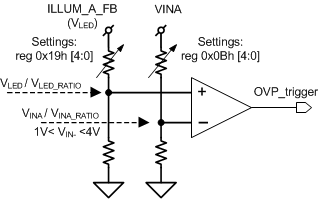DLPS240A June 2024 – August 2024 DLPA3085
PRODUCTION DATA
- 1
- 1 Features
- 2 Applications
- 3 Description
- 4 Pin Configuration and Functions
- 5 Specifications
-
6 Detailed Description
- 6.1 Overview
- 6.2 Functional Block Description
- 6.3
Feature Description
- 6.3.1 Supply and Monitoring
- 6.3.2 Illumination
- 6.3.3 External Power FET Selection
- 6.3.4 DMD Supplies
- 6.3.5 Buck Converters
- 6.3.6 Auxiliary LDOs
- 6.3.7 Measurement System
- 6.4 Device Functional Modes
- 6.5 Programming
- 6.6 Register Maps
- 7 Application and Implementation
- 8 Power Supply Recommendations
- 9 Layout
- 10Device and Documentation Support
- 11Revision History
- 12Mechanical, Packaging, and Orderable Information
Package Options
Mechanical Data (Package|Pins)
- PFD|100
Thermal pad, mechanical data (Package|Pins)
- PFD|100
Orderable Information
6.3.2.5.2 Ratio Metric Overvoltage Protection
The DLPA3085 illumination driver LED outputs are protected against open circuit use. In case no LED is connected and the DLPA3085 is instructed to set the LED current to a specific level, the LED voltage (ILLUM_A_FB) quickly rises and potentially rails to VIN; however, the OVP protection circuit triggers once VLED crosses a predefined level. As a result, the DLPA3085 is switched off, preventing overvoltage from occurring.
The same protection circuit is triggered in case the supply voltage (VINA) becomes too low for the DLPA3085 to work properly given the VLED level. This protection circuit is constructed around a comparator that senses both the LED voltage and the VINA supply voltage. The fraction of the VINA is connected to the minus input of the comparator while the fraction of the VLED voltage is connected to the plus input. Triggering occurs when the plus input rises above the minus input and an OVP fault is set. The fraction of the VINA must be set between 1V and 4V to ensure proper operation of the comparator.
 Figure 6-9 Ratio
Metric OVP
Figure 6-9 Ratio
Metric OVPIn general, an OVP fault is set when the following occurs:
| VLED/VLED_RATIO ≥ VINA/VINA_RATIO | ||
| thus when: | ||
| VLED ≥ VINA × VLED_RATIO/VINA_RATIO. |